Our mission is simple: We work to inspire wonder of the ocean by educating the world about octopuses.
We work with scientists, educators, and artists to make a global impact.
OctoNation® is a 501(c)(3) Nonprofit Organization
Octopus vulgaris
Octopus vulgaris means common octopus and was given to a group of octopuses that are commonly seen around the world in many habitats! You might have seen this species in the Oscar winning documentary, My Octopus Teacher. This octopus has a large brain to help disguise itself with its surroundings, navigate its environment, and make clever escapes.
This species is very important to scientists and engineers, for everything from ecology to neuroscience to robotics. They may be called “common” octopuses, but they’re really quite special!
4 ft long (1.3 m)
1-1.5 years
reef, seagrass, mud, sand
Crustaceans, bivalves, gastropods
Tropical, subtropical, and temperate seas worldwide
Sharks, eels, large fishes, marine mammals, seabirds
superpower
In a study comparing different species’ tendencies to escape from tanks, this octopus ranked highest on the escape-o-meter!
The species name Octopus vulgaris means “common octopus” and was originally described by Cuvier in 1797 likely from Mediterranean Sea specimens where they were most commonly encountered. It is considered the original Octopus vulgaris (sensu stricto; taxon being used in the sense of original author).
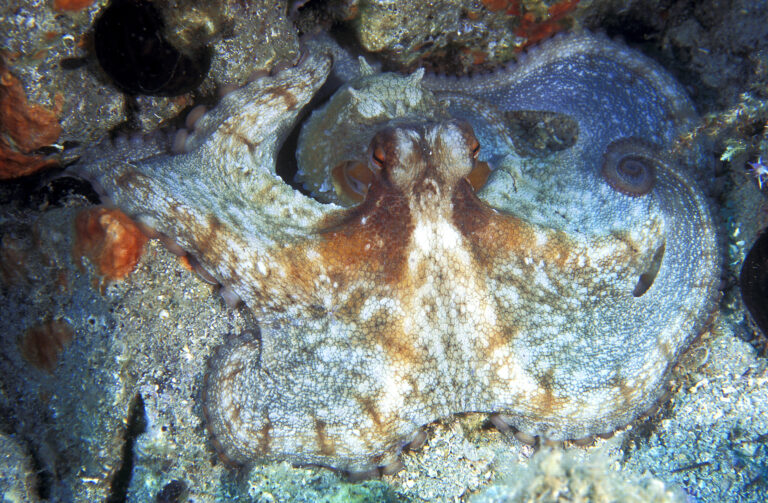
Since then, the species name Octopus vulgaris has been applied to four octopuses with different geographical distributions across tropical, subtropical and temperate waters worldwide and is known as the Octopus vulgaris species complex. This species complex includes: O. vulgaris type I (Caribbean Sea and North America), type II (along the coast of Brazil), type III (along the coast of South Africa), and type IV (Japan).
A number of studies have used molecular tools to gain insight on this complex group of octopuses. In 2016, type IV was renamed Octopus sinensis. Next, in 2019, a study suggested the existence of 6 (not 4 anymore) species belonging to the O. vulgaris complex: O. vulgaris sensu strictro, O. vulgaris type II, O. vulgaris type III, O. sinensis, O. tetricus (eastern Australia and northern New Zealand), and O. cf. tetricus (“cf” meaning compare this animal to O. tetricus to aid in identification).
Well glad that’s sorted out. Just kidding…plot twist:
An octopus species in the West Atlantic was first described in 1758 by Backer who called it Octopus americanus. Backer realized the octopus he examined was different from the common octopus from the Mediterranean and the Northwestern Atlantic. Since then, scientists have examined O. americanus-like specimens; however, the status of this species remained unresolved.
In 2016, it was found that this species’ distribution (Brazil to the Caribbean Sea) overlapped with that of O. vulgaris types I and II. Next question, is O. americanus actually O. vulgaris or another member belonging to the O. vulgaris species complex? *cue dramatic music*
In 2020, a study explored this question analyzing genetic information from 16 specimens tentatively identified as O. vulgaris type I from the Yucatan continental shelf. Results from this study indicated this was not O. vulgaris type I, but corresponded to O. vulgaris type II. It was also revealed that O. vulgaris type II was different from the original O. vulgaris (Mediterranean) and suggested that type II be renamed as O. americanus.
Long story short: it’s still complex. Further research is needed to clarify which species belong to the Octopus vulgaris species complex, especially in the Caribbean where it is a hot spot for marine biodiversity.
The following Information encompasses O. vulgaris species complex.
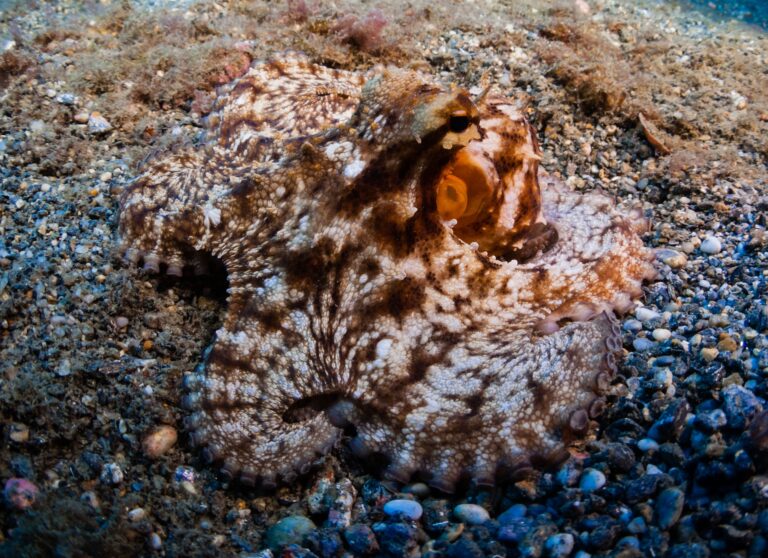
Considered to be a medium-large size octopus with adults commonly weighing 3-5 Kg (6-11 lbs). Mantle length to 250 mm (10 in); total length to around 1.3 m (4 ft). This species has stout arms (equal length and thickness) that are a moderate 3-5x mantle length (ML). In larger animals, this species has around 220 to 320 suckers on each arm.
Octopus Vulgaris, the common octopus lives for 12-18 months.
Found in temperate, subtropical, and tropical waters worldwide from nearshore shallow waters to the outer edge of the continental shelf (in depths from 0-200 m or 0-650 ft). Most scientists believe that O. vulgaris actually contains a number of related sister species. While this species, or species-complex, is very widely distributed around the world, its taxonomic and geographic parameters are still not precisely defined.
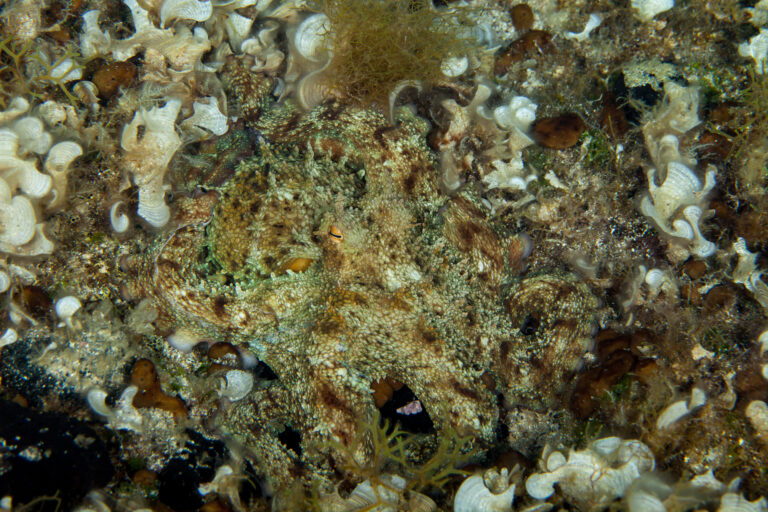
Benthic dwelling species that lives in a diversity of habitats such as coral reefs, coral rubble, seagrass beds, rock reefs, and occasionally mud and sand plains. It is typically associated with some type of structure for its home (rock, rubble, shells, sponge, coral, algae, seagrass, or man-made structure).
This species typically eats crustaceans, bivalves, and gastropods. After eating, the common octopus “decorates” its den with prey remains. These discards are called midden. This can help make the den opening smaller to stop predators from entering the den. Midden piles are useful to divers and scientists to help them locate an octopus. Scientists are interested in midden piles because it gives them an understanding of the octopus’s diet and what animals are in the area.
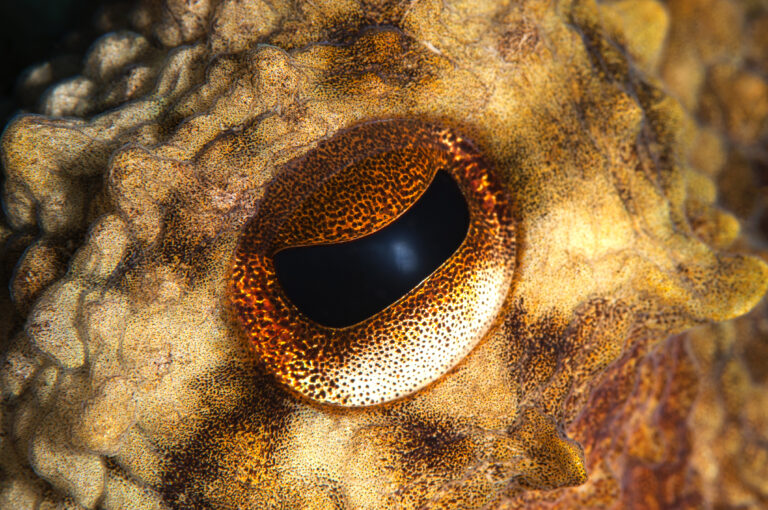
Living in a variety of complex habitats with many predators (like groupers, wrasses, eels, sharks, marine mammals, and marine birds) this species is equipped with a large brain that enables it to carry out a range of body patterns and behaviors. Its color can vary from yellow-brown to red-brown, dark brown, or grey.
Its skin has a distinct patch and groove system that forms a reticulate pattern and a pair of white spots on the dorsal mantle’s mid-region. It also has a diamond pattern of four large primary papillae in mid-region of dorsal mantle. There is one long primary papillae at the posterior end of the dorsal mantle, one large and two smaller primary papillae over each eye.
Its most distinguishing body pattern features include: highly variable mottle patterns (small-medium patches of contrast colors next to each other) and deimatic pattern (high contrast, pale body with dark eye ring and dark around suckers).
This species has a flexible activity period and has been reported to be active during the day and night! Its activity time can be influenced by predators, other octopus species inhabiting the same area, or potentially other environmental factors. A dense population of O. vulgaris and M. defilippi coexist in a South Florida lagoon in part because they partition their resources (habitat type, food, foraging activity time, and the substrate they search for food).
Throughout its distribution range, this species is known to undertake seasonal migrations. In the western Mediterranean, large mature or maturing individuals migrate inshore in early spring, followed by smaller, immature individuals. These two groups begin their retreat into deeper waters by August/September and November/ December respectively. Similar migration patterns have been observed in Florida (more research is needed for this area) and in other areas.
This octopus typically uses the crawling behavior, continuous slow movement of the mantle from one physical location to another when the arms are in contact with the substrate, to move across a structured habitat. Octopuses are experts at background matching. However, with flexible arms and a soft bodied not constricted to a rigid shell, they are capable of other types of camouflage.
Octopuses (and their relatives’ squids and cuttlefishes) use arm postures to look like objects in their environment such as stones, algae, corals, and seagrasses. This is known as masquerade and is widespread among shallow-water octopuses. They can add motion to these postures (motion camouflage) to decrease the chances of being detected by a predator as the octopus moves across open areas.
The speed of the octopus generally resembles the speed of the rippling light from the waves. O. vulgaris uses the “moving rock” trick when smooth coral heads or rocks are in its surrounding environment and uses the “moving algae” trick when algae are nearby.
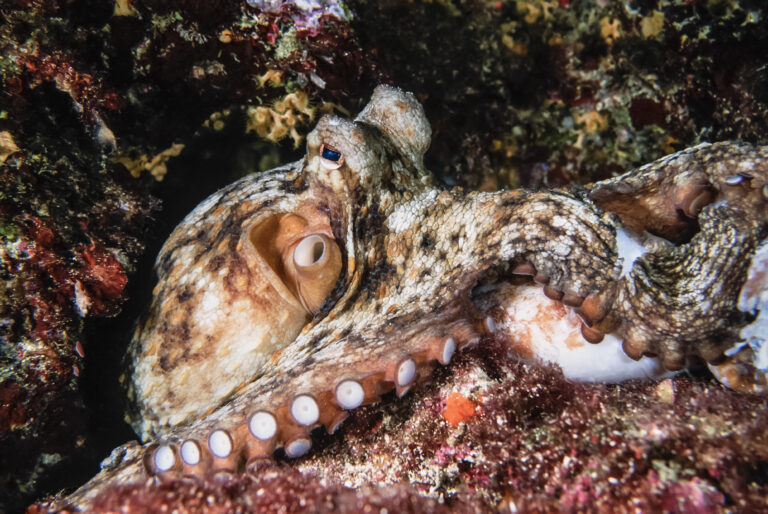
This species has been studied across many scientific fields such as biology, ecology, evolution, neuroscience, marine drugs, fisheries, aquaculture, physiology, soft bio-inspired robotics, and marine pollution (it could act as a bio-indicator of the quality and health of the coastal ecosystems).
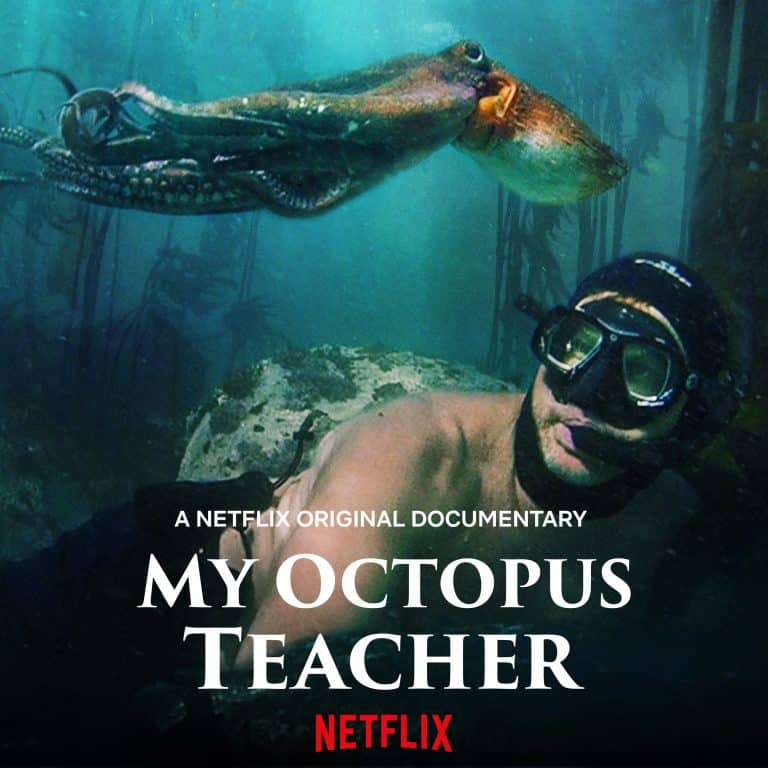
Hanlon RT (1988) Behavioral and body patterning characters useful in taxonomy and field identification of cephalopods. Malacologia 29:247-264
Humann P, DeLoach N (2013) Reef Creature Identification: Florida-Caribbean-Bahamas. New World Publications, Jacksonville, FL
Norman MD, Finn JK (2016) World octopod fisheries. In: Jereb P, Roper CFE, Norman MD, Finn JK (eds) Cephalopods of the World. An Annotated and Illustrated Catalogue of Cephalopod Species Known to Date. FAO Species Catalogue for Fishery Purposes, vol 4, 3rd edn. FAO, Rome
Hanlon R, Vecchione M, Allock L. 2018. Octopus, Squid, and Cuttlefishes. A visual, scientific guide to the oceans’ most advanced invertebrates. University of Chicago Press, Chicago, IL. 224p
Amor MD, Doyle SR, Norman MD, Roura A, Hall NE,Robinson AJ, Leite TS, Strugnell JM (2019) Genome-wide sequencing uncovers cryptic diversity and mito-nucleardiscordance in the Octopus vulgaris species complex. BioRxiv. https://doi.org/10.1101/573493
Bennice CO, Rayburn AP, Brooks WR, Hanlon RT (2019) Fine-scale habitat partitioning facilitates sympatry between two octopus species in a shallow Florida lagoon. Marine Ecology Progress Series 609:151-161. doi: 10.3354/meps12845
Avendaño et. al (2020) Octopus americanus: a cryptic species of the O. vulgaris species complex redescribed from the Caribbean. Aquat Ecolo. https://doi.org/10.1007/s10452-020-09778-6(0123456789().,-volV() 0123458697().,-volV)
Our mission is simple: We work to inspire wonder of the ocean by educating the world about octopuses.
We work with scientists, educators, and artists to make a global impact.
OctoNation® is a 501(c)(3) Nonprofit Organization
| Cookie | Duration | Description |
|---|---|---|
| cookielawinfo-checkbox-analytics | 11 months | This cookie is set by GDPR Cookie Consent plugin. The cookie is used to store the user consent for the cookies in the category "Analytics". |
| cookielawinfo-checkbox-functional | 11 months | The cookie is set by GDPR cookie consent to record the user consent for the cookies in the category "Functional". |
| cookielawinfo-checkbox-necessary | 11 months | This cookie is set by GDPR Cookie Consent plugin. The cookies is used to store the user consent for the cookies in the category "Necessary". |
| cookielawinfo-checkbox-others | 11 months | This cookie is set by GDPR Cookie Consent plugin. The cookie is used to store the user consent for the cookies in the category "Other. |
| cookielawinfo-checkbox-performance | 11 months | This cookie is set by GDPR Cookie Consent plugin. The cookie is used to store the user consent for the cookies in the category "Performance". |
| viewed_cookie_policy | 11 months | The cookie is set by the GDPR Cookie Consent plugin and is used to store whether or not user has consented to the use of cookies. It does not store any personal data. |